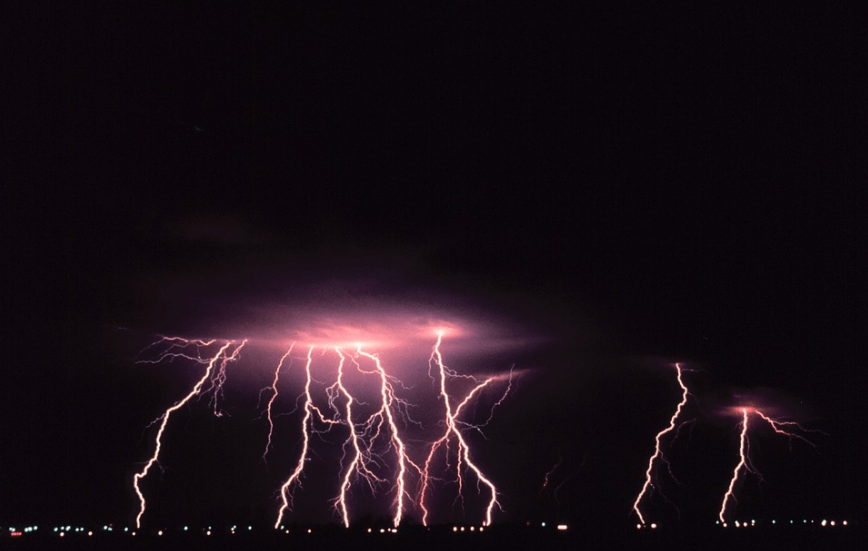Red lightning or red sprites are large-scale electric discharges occurring overhead cumulonimbus or thunderstorm clouds, causing a wide range of visual shapes to flicker in the night sky. They are typically brought on by the positive lightning discharges between the ground and an underlying thundercloud.
These luminous reddish-orange flashes usually happen at an altitude range of around 50–90 km or 31–56 mi in clusters over the troposphere. Occasional visual reportings of red lightning go back to at least 1886. Still, scientists from the University of Minnesota took the first photograph on July 4, 1994, and since then, they have captured numerous video recordings, reaching thousands.
Red sprites are sometimes mistakenly tagged upper-atmospheric lightning. However, red lightning is a cold plasma phenomenon that doesn’t have the hot channel temperatures that tropospheric lightning has, so they’re more similar to fluorescent tube discharges than lightning discharges. Sprites are also associated with many other upper-atmospheric optical phenomena, including ELVES and blue jets.
History of Red Lightning
The earliest record of transient optical phenomena over thunderclouds is by Johann Georg Estor, a German theorist of law, in 1730. Another early account is done in 1886 by Mackenzie and Toynbee. In 1925, C.T.R. Wilson, a Nobel laureate, had suggested on theoretical grounds that an electrical breakdown can happen in the upper atmosphere. Then, Wilson had witnessed what could have possibly been a sprite in 1956. The first document photograph of red lightning was on July 6, 1989, after scientists from the University of Minnesota unwittingly captured the first image of what was soon known as a sprite with a low-light video camera. Years later, after their accidental discovery, they were termed sprites (named after their elusive nature).
Since the video capture in 1989, red sprites have been imaged from space, the ground, and an aircraft and grew to be the subject of exhaustive investigations. In 2016, red lightning was observed during the passage of Hurricane Matthew into the Caribbean. The sprites’ role in tropical cyclones is currently undetermined.
Characteristics of Red Lightning
Red lightning has been observed all over North, Central, and South America, Australia, Europe, the Sea of Japan, Asia, and Central Africa (Zaire). It is believed to happen through most large thunderstorm systems.
Sprites are categorized into three types according to their visual appearance:
- Column sprite (C-sprite) – huge-scale electrical discharges over the Earth still aren’t fully understood.
- Carrot sprite – a column sprite that has long tendrils
- Jellyfish sprite – huge, up to 50 by 50 km or 31 by 31 mi
Red sprites are reddish-orange around their upper areas and bluish hanging tendrils underneath. Sometimes, this phenomenon is preceded by a reddish halo. Sprites also last longer than the typical lower stratospheric discharges that usually last for a few milliseconds. They are generally triggered by the bursts of positive lightning between the ground and the thundercloud, although red lightning produced from negative ground flashes was also observed. Sprites frequently occur in two or more clusters and usually have an altitude range of 50 to 90 kilometers, with what seem to be tendrils hanging under and branches stretching above.
Sprites are shown to be clusters of tiny, decameter-sized balls of ionization launched at an altitude of around 80 km (50 mi) and then go downward at a speed of up to 10% the speed of light, succeeded by a different set of upward-going balls of ionization a few milliseconds later.
To film red lightning from Earth, specific conditions must be met: a clear view of a powerful thunderstorm within 150–500 km (93–311 mi) with positive lightning between ground and cloud, a dark black sky, and a red-sensitive recording device.
Sprite Halo
A sprite halo, a pancake-shaped zone of weak, transient optical discharges about 10 kilometers (6.2 mi) across and 50 kilometers (31 mi) thick, sometimes precedes red lightning for around one millisecond. These halos are believed to be generated by a similar physical process that creates sprites, but for which the ionization isn’t strong enough to cross the threshold needed for streamer formation. They are also sometimes confused with ELVES because of their short duration and visual similarity.
A 2000 research done at Stanford University indicates that sprite halos occurrence is not strange in association with normal lightning discharges, unlike red lightning that has a bright vertical columnar structure. In addition, scientists at Tohoku University researched in 2004 and found that very low-frequency emissions happen simultaneously with the sprite, showing that a discharge inside the cloud may produce the sprites.
Is Red Lightning Dangerous?
Sprites are called red sprites or red lightning because most of them glow red. These wispy flashes can shoot up to 96.6 kilometers (60 mi) from above the cloud. However, since sprites are weakly charged and rarely last more than a couple of seconds, they can’t be considered dangerous.



